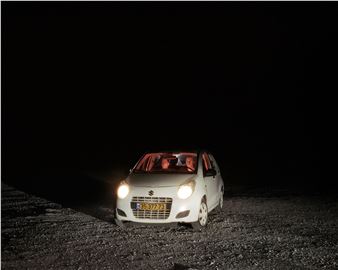Boaz Noy: Edge of the Night (A New Day)
The exhibition begins in the project space (Rosy) located at the gallery entrance. The installation in this intimate room marks another chapter in Boaz Noy's artistic trajectory, culminating in both the solo exhibition and the book The Garden Keeper. As is typical of Noy's work, the end of one period seamlessly transitions into the beginning of another, equally exciting phase. While his medium remains unchanged-oil paints on stretched linen canvas-and his themes and sources of inspiration continue to center around Haifa, Tel Aviv, and Jerusalem, three cities that deeply resonate as his homes, the innovation lies in the paintings' style and the state of mind they convey.
The urban space is in constant motion. Familiar places fade away, while new ones are discovered, often by chance. The city reveals its many faces in different areas and at different times, throughout both day and night. In the film In Bruges (McDonagh, 2008), two assassins are sent on "vacation" to the crepuscular city of Bruges, Belgium. During one of their walks, they come across a bell tower that offers a view of the entire city. A brief conversation between the older Ken and the younger Ray highlights the generational gap and differing attitudes between them. Ken: "You're going up there?" Ray: "What's up there?" Ken: "A view." Ray: "A view of what? A view of down here? I can see it from here."1
The choice to observe the city from below reflects Noy's preferred perspective. He is not drawn to a sweeping, bird's-eye view or the grandeur of an iconic skyline. Instead, it is the city at ground level that captures his attention and emotions. In its streets and gardens, he focuses on those seemingly ordinary, esoteric moments: a flowering chinaberry between buildings on a side street in Tel Aviv; a well-tended community garden tucked away in a Jerusalem alley. In his paintings, the city is broken down into its elements- a house wall, light spilling from an apartment window, a pine tree, a public garden, a tiled roof. It is the very ordinariness of these subjects that allows Noy's subjective experience and inner emotions to be fully transferred onto the canvas. Harmonious perspectives and balanced compositions give way to abstraction and expressive forms. As a result, the works in this exhibition are defined by vivid, contrasting colors, and a rich array of signs, lines, engravings, scratches, and color erasures. These elements create a bold, self-contained statement, resisting absorption into traditional pictorial harmony.

Recommended for you
The exhibition begins in the project space (Rosy) located at the gallery entrance. The installation in this intimate room marks another chapter in Boaz Noy's artistic trajectory, culminating in both the solo exhibition and the book The Garden Keeper. As is typical of Noy's work, the end of one period seamlessly transitions into the beginning of another, equally exciting phase. While his medium remains unchanged-oil paints on stretched linen canvas-and his themes and sources of inspiration continue to center around Haifa, Tel Aviv, and Jerusalem, three cities that deeply resonate as his homes, the innovation lies in the paintings' style and the state of mind they convey.
The urban space is in constant motion. Familiar places fade away, while new ones are discovered, often by chance. The city reveals its many faces in different areas and at different times, throughout both day and night. In the film In Bruges (McDonagh, 2008), two assassins are sent on "vacation" to the crepuscular city of Bruges, Belgium. During one of their walks, they come across a bell tower that offers a view of the entire city. A brief conversation between the older Ken and the younger Ray highlights the generational gap and differing attitudes between them. Ken: "You're going up there?" Ray: "What's up there?" Ken: "A view." Ray: "A view of what? A view of down here? I can see it from here."1
The choice to observe the city from below reflects Noy's preferred perspective. He is not drawn to a sweeping, bird's-eye view or the grandeur of an iconic skyline. Instead, it is the city at ground level that captures his attention and emotions. In its streets and gardens, he focuses on those seemingly ordinary, esoteric moments: a flowering chinaberry between buildings on a side street in Tel Aviv; a well-tended community garden tucked away in a Jerusalem alley. In his paintings, the city is broken down into its elements- a house wall, light spilling from an apartment window, a pine tree, a public garden, a tiled roof. It is the very ordinariness of these subjects that allows Noy's subjective experience and inner emotions to be fully transferred onto the canvas. Harmonious perspectives and balanced compositions give way to abstraction and expressive forms. As a result, the works in this exhibition are defined by vivid, contrasting colors, and a rich array of signs, lines, engravings, scratches, and color erasures. These elements create a bold, self-contained statement, resisting absorption into traditional pictorial harmony.














